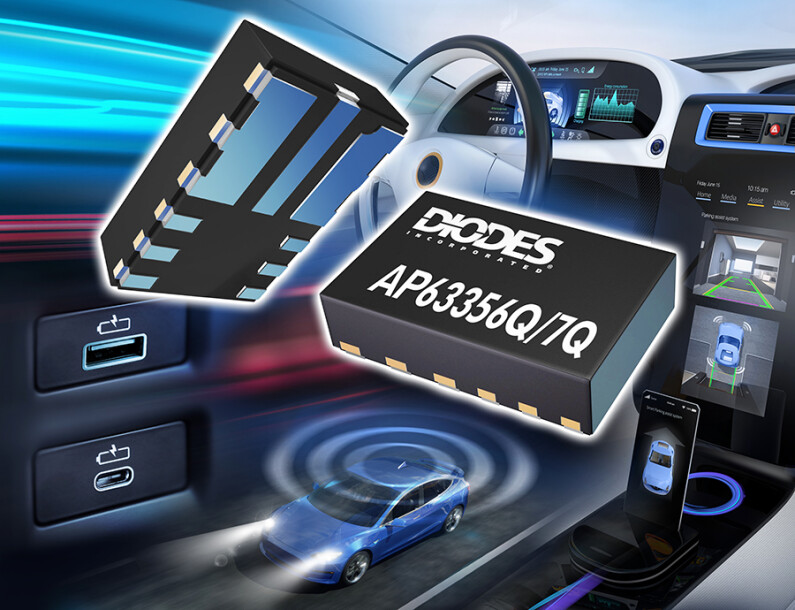How the Latest Switching Converters Deliver More Power, Lower Losses, and Less Noise in Automotive Applications

By: Ben Tang, Business Development Manager for Power Products
Electronic features are key selling points of today’s vehicles, and are arguably more important than looks or performance. Driver-assistance systems, dynamic aids, and infotainment—including connectivity and charging for mobile devices via the latest Bluetooth® and USB-C® interfaces—are among crucial aspects that determine the buying decision.
To handle infotainment and smart driving modes, as well as engine and chassis control, body electronics, and lighting, the number of electronic control units (ECUs) needed onboard modern vehicles has been increasing relentlessly in recent years.
High-end vehicles can contain from 50 ECUs to over 100. More recently, the trend has started moving towards consolidating the functions of multiple ECUs into domain control units (DCUs) and multi-domain controllers (MDCs), which simplify the vehicle’s hardware architecture and help reduce the cost and weight of vehicle wiring.
The circuitry inside any of these modules, whether it is an ECU, DCU, or MDC, is dependent upon a stable supply of power. A suitable power supply must ensure consistent power quality, preventing any drops in the battery voltage from interrupting operation and protecting the modules’ internal circuitry against overvoltages during events such as load dumps or battery disconnection.
Moreover, as power demand rises with increasing on-board computing and communication performance, energy efficiency is an increasingly important performance metric for power supplies to help manage heat dissipation within the vehicle and minimize energy losses. With the transition to electric and hybrid powertrains, electrical energy consumption is becoming more closely linked with driving range.
Integration and Efficiency
Diodes Incorporated’s AP63356Q and AP63357Q converters deliver an automotive-compliant, integrated solution that leverages synchronous rectification to maximize energy efficiency. At light loads, the AP63357Q operates in pulse-frequency mode (PFM) to minimize energy losses. As a result, the efficiency remains as high as 86% at 5mA load, and the quiescent current is just 22µA under no load.
The converters deliver up to 3.5A output current and operate with an input-voltage ranging from 3.8V to 32V. They operate with peak current mode control, which minimizes the number of external components needed to complete the circuit. With the high-side and low-side MOSFETs also on-chip, the combination of state-of-the-art topology and advanced integration help maximize reliability while also reducing the bill-of-materials cost and saving PCB space.
Features such as UVLO, cycle-by-cycle peak current limit, thermal shutdown, and support for power sequencing further aid reliability by guarding against system faults. Power sequencing is aided by a Power Good indicator with an internal 5MΩ pullup resistor, and an enable pin designed with accurate thresholds to allow adjustment of the power-on voltage.
Low-Noise Performance
With so many different electronic systems and modules powered by switched-mode converters in the vehicle, all these devices must coexist without interfering with each other—for the sake of the user experience and safety. Electromagnetic compatibility is critical. Diverse specifications, such as IEC and ISO standards for various types of equipment, may apply and the demands can be high.
The AP63356Q and AP63357Q are designed to minimize the effects of power supply switching noise in the vehicle’s electromagnetic environment. They use a proprietary gate-driver scheme that ensures clean switching transitions with fast turn-on and turn-off times while preventing switch-node ringing. In addition, frequency spread spectrum (FSS) operation disperses switching-noise energy by varying the switching frequency at ±6% around the nominal frequency of 450kHz.
The Latest Converters in Action
While in their vehicles, drivers and passengers want to use and charge these new consumer devices that enter the market. Thus, the AP63356Q and AP63357Q converters have become a popular choice for USB-C charging-port bus applications. Their 3.5A output current capability via different fast-charging standards, such as Quick Charge™, supports up to 27 Watts. Their low shutdown current of 0.6µA, when disabled, saves system power in standby operation.
Bluetooth® is a registered trademark owned by Bluetooth SIG, Inc.
USB-C® is a registered trademark of USB Implementers Forum.
Quick Charge™ is a trademark of Qualcomm Incorporated.
